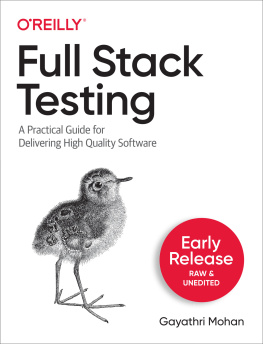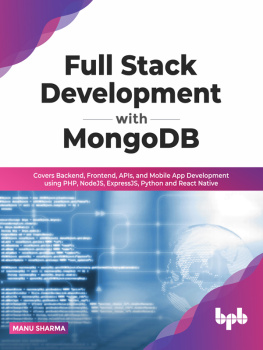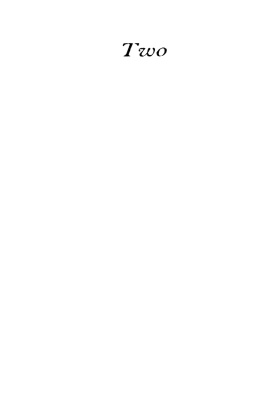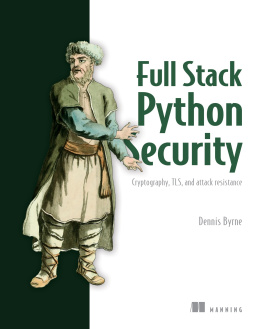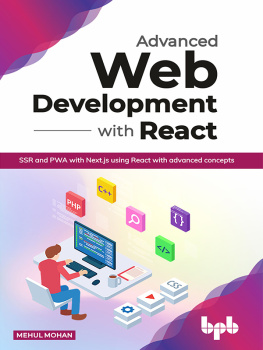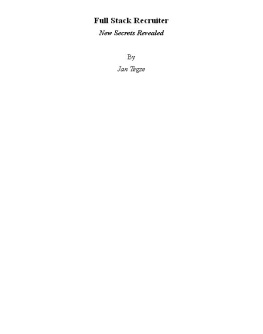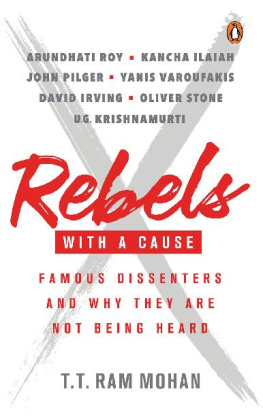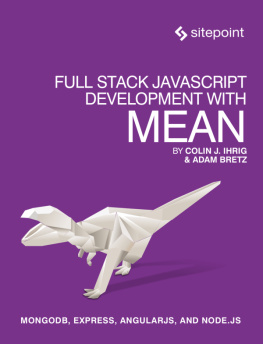Gayathri Mohan - Full Stack Testing
Here you can read online Gayathri Mohan - Full Stack Testing full text of the book (entire story) in english for free. Download pdf and epub, get meaning, cover and reviews about this ebook. year: 2022, publisher: OReilly Media, Inc., genre: Computer. Description of the work, (preface) as well as reviews are available. Best literature library LitArk.com created for fans of good reading and offers a wide selection of genres:
Romance novel
Science fiction
Adventure
Detective
Science
History
Home and family
Prose
Art
Politics
Computer
Non-fiction
Religion
Business
Children
Humor
Choose a favorite category and find really read worthwhile books. Enjoy immersion in the world of imagination, feel the emotions of the characters or learn something new for yourself, make an fascinating discovery.
- Book:Full Stack Testing
- Author:
- Publisher:OReilly Media, Inc.
- Genre:
- Year:2022
- Rating:5 / 5
- Favourites:Add to favourites
- Your mark:
- 100
- 1
- 2
- 3
- 4
- 5
Full Stack Testing: summary, description and annotation
We offer to read an annotation, description, summary or preface (depends on what the author of the book "Full Stack Testing" wrote himself). If you haven't found the necessary information about the book — write in the comments, we will try to find it.
Full Stack Testing — read online for free the complete book (whole text) full work
Below is the text of the book, divided by pages. System saving the place of the last page read, allows you to conveniently read the book "Full Stack Testing" online for free, without having to search again every time where you left off. Put a bookmark, and you can go to the page where you finished reading at any time.
Font size:
Interval:
Bookmark:

by Gayathri Mohan
Copyright 2021 Gayathri Mohan. All rights reserved.
Printed in the United States of America.
Published by OReilly Media, Inc. , 1005 Gravenstein Highway North, Sebastopol, CA 95472.
OReilly books may be purchased for educational, business, or sales promotional use. Online editions are also available for most titles (http://oreilly.com). For more information, contact our corporate/institutional sales department: 800-998-9938 or corporate@oreilly.com .
- Acquisitions Editor: Melissa Duffield
- Development Editor: Jill Leonard
- Production Editor: Daniel Elfanbaum
- Interior Designer: David Futato
- Cover Designer: Karen Montgomery
- Illustrator: Kate Dullea
- March 2022: First Edition
- 2021-07-13: First Release
- 2021-08-24: Second Release
See http://oreilly.com/catalog/errata.csp?isbn=9781098108137 for release details.
The OReilly logo is a registered trademark of OReilly Media, Inc. Full Stack Testing, the cover image, and related trade dress are trademarks of OReilly Media, Inc.
The views expressed in this work are those of the author, and do not represent the publishers views. While the publisher and the author have used good faith efforts to ensure that the information and instructions contained in this work are accurate, the publisher and the author disclaim all responsibility for errors or omissions, including without limitation responsibility for damages resulting from the use of or reliance on this work. Use of the information and instructions contained in this work is at your own risk. If any code samples or other technology this work contains or describes is subject to open source licenses or the intellectual property rights of others, it is your responsibility to ensure that your use thereof complies with such licenses and/or rights.
978-1-098-10806-9
[LSI]
With Early Release ebooks, you get books in their earliest formthe authors raw and unedited content as they writeso you can take advantage of these technologies long before the official release of these titles.
This will be the 1st chapter of the final book. Please note that the GitHub repo will be made active later on.
If you have comments about how we might improve the content and/or examples in this book, or if you notice missing material within this chapter, please reach out to the editor at .
In todays world, digitalization is inevitable to sustain and grow any business. Many businesses are leading the way in this aspect, while some are in the early phases of modernizing their existing digital platforms.
Digitalization is key to broadening a businesss reach from a local community to a global scale, translating to more adoption and more revenue. Almost all small and large-scale enterprises in various sectors, like health care, retail, travel, academics, social media, banking, entertainment, devise plans to advance their digital strategies as a critical measure to yield higher profits.
In this journey towards digitalization and modernization, innovation becomes a crucial driver. We can see the businesses that innovate constantly continue to thrive over many decades. Netflix is a classic example. It started as an online DVD rental portal in the 1990s. It ventured into movie streaming, making its own DVD rental business obsolete in the 2000s. It later started producing original content called Netflix Originals. As of 2021, Netflix is the largest online media subscription platform with over 200 million subscribers.
The technology space has been evolving in parallel to these innovative businesses to accommodate their increasingly advanced needs. Gone are the days where we were willing to wait in line to buy movie tickets, visit a store in a remote location to buy a specialty product, or carry around a hand-written shopping list searching for specifics. Technology eases everyday tasks extensively. We can sit at home and stream our favorite entertainment programs in one touch, try a new dress virtually, schedule our shopping list to be delivered regularly, and do even morebrew a coffee with voice command!
With such rapid evolution in technology, product strategy must be versatile, catering to different customer needs to survive the ongoing competition in their respective sectors. It has to expand its horizons beyond just building websites. Consider the ride-hailing companies, such as Uber and Lyft, which provide their services at our fingertips in various waysthe web, Android, and iOS mobile platforms. In some regions, they even provide tele-booking services through interactive voice response systems (IVR) and call centers. This kind of versatile product strategy has helped them expand across the globe and outgrow competitors.
With such versatile product strategy and innovation, the businesses become successful in acquiring a critical mass of customers. But now, the next challenge is to thrive furtherearn more revenue and more customers. We can see the giants in the industry, such as Amazon, leveraging their existing customer base to cross-sell services & products as a strategy to expand beyond. Amazon, which started as an online bookstore, now cross-sells various products ranging from fresh pantry items to electronics to retail products and more, meeting customer demand for consumer goods in nearly every market segment.
Todays software industry caters to all these business needsinnovate new product ideas, bring them to life, and scale them to reach new customer segments across the globe. To aid the process, they continuously learn new technologies. Unquestionably, the software development teams are standing on the edge, especially when the need for the hour is to deliver all of that with high quality!
Software quality is a non-negotiable criterion when it comes to sustaining a business in the long term. There are many examples of how a glitch in software quality can affect reputation and result in big loss for the businesses. For example, in October 2014, on Big Billion Day sale, the two Indian eCommerce giants SnapDeal and Flipkart went head to head on their seasonal sale. Flipkarts website crashed multiple times during the day due to overwhelming demand, losing their sales to Snapdeal.
We can see many such examples across the globe, where businesses albeit their novel product ideas, slip down a steep slope as customers quickly move on to more reliable competitors when quality is compromised. As a result, we can firmly say that quality is quintessential for sustaining a business in the long term.
Such high software quality can be reaped only by a combination of skillful development and meticulous testing. In particular, when I say meticulous testing, I refer to paying attention to every aspect of the application throughout its stack in various facets. This chapter will introduce the breadth of such full stack testing, which has to be performed for a typical web or mobile application.
So, to begin with, let us come together on a common understanding of software quality.
Software quality was once equated to a bug-free application. Anyone in the software world today will agree that its not just that anymore. If you ask end-users to define quality, we will hear them speak of ease of use, look and feel, data privacy, swiftness in rendering information, and availability of services 24/7. If you ask businesses to define quality, we will hear them speak about reusable code, real-time analytics, zero downtime, no vendor lock-in, scalable infrastructure, data security, legal compliance, and more. All of these are what make an application a high-quality software. A slack in any of these aspects would affect the quality in some way or the other, which is why we need to test for them meticulously!
Font size:
Interval:
Bookmark:
Similar books «Full Stack Testing»
Look at similar books to Full Stack Testing. We have selected literature similar in name and meaning in the hope of providing readers with more options to find new, interesting, not yet read works.
Discussion, reviews of the book Full Stack Testing and just readers' own opinions. Leave your comments, write what you think about the work, its meaning or the main characters. Specify what exactly you liked and what you didn't like, and why you think so.

